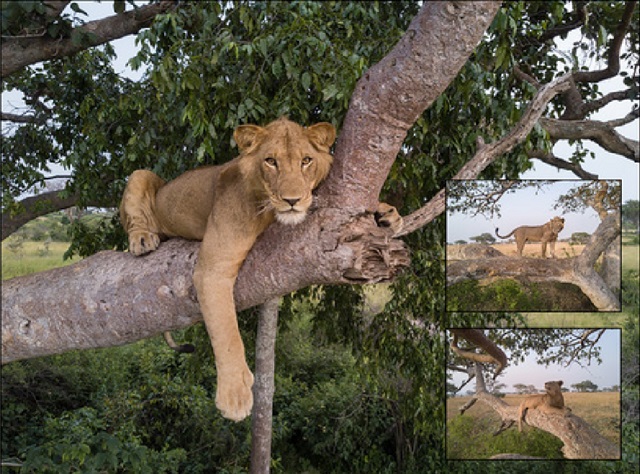
Uganda lions in danger

Numbers fewer than earlier indicated
| THE INDEPENDENT | Ugandan lions are one of the most sought-after animals by tourists. This means they have great local tourism value as each lion raises about USD$ 14,000 (Approx. Shs52million) annually in park fees, according to official figures.
Tourists find Ugandan lions interesting because they have a rare culture; they climb trees. But the same culture might be putting the lions at risk, according to findings of a new study of lions in the Queen Elizabeth Conservation Area (QECA) of southwestern Uganda.
The Queen Elizabeth Conservation Area, which measures 2,400 km2 and comprises the Queen Elizabeth National Park (1,977 km2), the Kyambura wildlife reserve (154 km2), and the Kigezi Wildlife Reserve (269 km2), is famous for its tree climbing lions.
But their culture of climbing trees may have led to unusually high detection rates of lions and misled field workers to be satisfied in applying less‐robust lion monitoring methods.
The status of lions in Uganda has not been very well understood. After a wave of intense poaching during the unstable Idi Amin and Milton Obote regimes – 1971 to 1985 – during which time wildlife numbers plummeted, the numbers are believed to be recovering.
Previous surveys, from 2006 to 2010, had showed that lions in Queen were in good health. But the new findings appear to contradict that.
The authors of the new study say their review shows that the majority of methods used to count lions are not robust enough. According to them, making sure that lion numbers are accurate and reasonably precise is key for the species’ conservation.
“Estimates of lion numbers underpin their classification as ‘vulnerable’. They also form the backbone for controversial management practices like the setting of trophy hunting quotas,” they say.
The researchers argue that previous findings that showed high numbers were based on faulty estimations because they used aerial and radio-collaring surveys. Some were based on expert opinions, total counts of lion sightings, and counts of lions lured by targeted audio. The lion’s culture of climbing trees may have led to unusually high detection rates of lions and may have led researchers to estimate their numbers to be higher than they actually are.
In the new study, the researchers argue that “The population of lions in QECA is under threat and densities are likely to be significantly lower than what is ecologically possible in this area”.
They point out how, in previous surveys, erroneous assessment of the health of the lion population was made based on wrong assessment of the distances the lions have to travel to find food.
Availability of food or prey is one of the key factors in shaping the density and movements of lions in an area. In some previous surveys, the distances lions travelled were estimated to be short and short distances to food were deemed to be good predictors of abundance of food which, in turn was seen as a good predictor of good health.
But in the new report, the researchers say commercial and subsistence poaching of lion prey species is widespread across the QECA, and parts of the Ishasha sector, the park’s lake edges and rivers. According to the new study, lions in the Queen area have to in fact travel longer distances to find food; with males travelling twice as long as females.
“We suggest the increased movements of lions we detected are likely a response to systematic prey depletion in the broader QECA,” the researchers say.
Previous studies also missed another important indicator about the lions in Queen; their skewed sex ratios.
Killing lions
The new survey found that there was only one female lion for every male in the Queen Elizabeth Conservation Area. According to them, this is very different to other African lion populations which have a much higher proportion of females relative to males (about two females for every male).
The researchers say this may be due to direct killing of lions by people living in villages located within and on the boundaries of the QECA. This is because female lions often venture into community lands to feed on vulnerable livestock.
In the northern section of the park alone, at least 47 adult and sub‐adult lions were killed between 2006 and 2012, equating to at least seven lions being killed annually. This, according to the scientists, could lead to the population of lions in Queen “collapsing” or long-term population decline.
“From the standpoint of lion conservation and recovery these results are concerning. But, on a positive note, this finding has provided a timely alert,” the researchers say.
The findings were first released on June 16, 2020 in a study titled ‘Detecting early warnings of pressure on an African lion (Panthera leo) population in the Queen Elizabeth Conservation Area, Uganda’ that is published by the British Ecological Society (BES) journals.
The study was carried out in the Queen Elizabeth Conservation Area (QECA) from October 2017 to February 2018 by four researchers from two universities. The researchers included Prof. Alexander Richard Braczkowski and Senior Research Fellow Duan Biggs from Griffith University and Postdoctoral research fellow James R. Allan from the University of Amsterdam and ARC Future Fellow and Professor of Environmental Management Martine Maron of the University of Queensland.
The post Uganda lions in danger appeared first on The Independent Uganda:.
0 Response to "Uganda lions in danger"
Post a Comment